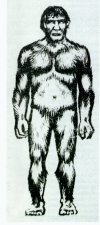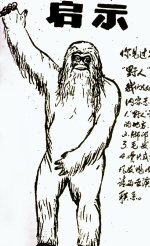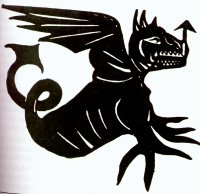


The Yeren
is another hairy biped that resides on the Asian Continent, particularly
in central/southern China. The Yeren is 6-9ft tall, manlike features,
covered with hair and lives in caves. A biologist, Wang Tselin, claimed
to have seen a dead female yeren in the 1940's. He described it as
half ape, half man with grayish brown hair. In 1976, 6 local
government officials observed a manlike creature on a road in Chunshuya.
They described is as 6ft tall, brown red hair, human-like eyes and monkey
-like face. There has also been reported sightings of a smaller version
of the yeren which stood 3ft tall. Hair samples were were found and
tested at East China Normal University. They found that the samples
were different from any known primate but more closely resembled human
hair.

In 600 B.C., an
artist carved 3 animals in the archway of the Ishtar Gate in Babylon.
The three animals were a lion, an wild ox and the sirrush. Why was
this supposedly mythical creature pictured with two known animals?
Was it because it wasn't a myth? The sirrush was described
as slender bodied, scale covered creature with a horn atop it's head.
Nebuchadnezzar was the king of Babylonia at the time and The Bible mentions
that his priests kept a great dragon or serpent that they worshipped.
The creature closely resembles a type of dinosaur, a sauropod. Since
the Babylonians did not have the ability to reconstruct fossil remains
it is more likely they were drawing a living animal that they has seen.
The drawings and carvings of the sirrush were always the same and never
varies which normally indicates they were based on a real creature.
This article is courtesy of The World of The Strange
There has been
much written in by scientists, natural history researchers,cryptozooligists,historians
and collectors of fokelore, about the elusive "Yowie". Just where
does all of this come from. Many
Aboriginal groups
from around Australia have oral traditions that date back thousands of
years. Included in much of their lore are Dreaming stories concerning
large, often black giants. Many of their stories contain references
to long extinct megafauna. Diprotodons, marsupial lions, giants
wombats, giant
red kangaroos, just to name a few.
Many of these animals died out when the climate changed. Others succumbed to the predations of humans, particularly when they introduced the wide spread use of fire as a hunting and environment altering tool. Along with humans came the dingo about 10000 years ago, the introduction of this animal and its impact on native fauna cannot be underestimated. Yet other evolved down into their more compact modern forms.
Many people mistakinly believe that Aboriginal people have always occupied all parts of Australia. THIS IS NOT SO! Different parts of the continent were occupied at different times, and there were at least 3 waves of aboriginal people who migrated down through the south eastern parts of Australia. I use the example of the indigenous people of Tasmania. Tasmania had been cut off from the Australian mainland for at least 5000 years before settlement. The people who lived on the island prior to 1788 were different.
Contrary to popular
opinion they were not wiped out by early European settlers. The survivors
who took refuge on off shore islands are descended from a people whose,
language, culture and physical appearance was distinct from the Aboriginal
people at the time of settlement in 1788. Their culture
and tools were
very much like those of the people whose cultural remnants have been found
on Kangaroo Island off the coast of South Australia. The last known
indigenous inhabitants disappeared some 5000 years ago. The physical
evidence is further enhanced by the discoveries made in the Lower Murray
Valley at a place called Tartanga. Found in a grave on an island
in
the river was
the body of a Tasmanian. Further archaeological evidence suggests
that the original inhabitants of the Lower Murray Valley were directly
related to the Tasmanian people, and were either driven out or intermarried
with later waves of Aboriginal people who moved down the valley.
Why go through
all of this to try to explain the origins of the Yowie? As already
mentioned Australia was a land of giants long before its current state.
The land was much greener in many places, particularly in the 'Dead Heart',
10000 years ago that all changed. Historical records from around
the world state
that in many places indigenous peoples were generally larger than many
who migrated to those areas. Remember we are talking about eons of
existence in one place. As the climate of the world changed, many
people migrated, animals and plants evolved into smaller forms of themselves.
If animals did, why couldn't humans?
The Kaurna people
of the Adelaide Plains have a story that records the flooding of the Gulf,
this occurred over 5000 years prior to today. They also have stories
that cover their migration form central Australia. The language of
the Kaurna people whilst distinct traces its origins back to the
central desert
of Australia. It shares a common root with Pitjantjatjarra.
The Kaurna people migrated south when the climate changed, along the way
they fragmented into different groups who occupied different geographical
regions . This way those who migrated from central Australia became The
Kaurna, the Peramangk,
the Ngadjuri, the Narranga, the Adnyamathanah, the Nauo and the Nukunu.
When the Kaurna arrived on the plains they encoutered a people who were
different to themselves. The people resembled the Tasmanians and
the cultural debris left behind supports this. In many of
the Kaurna stories
these people fled to the hills. The Kaurna people referred to them
as giants with po! werful magic and sorcery. The Kaurna people
also reffered to a large,hairy giant called a Nookoona. It would
come in the middle of the night, creep up to people as they slept and kill
them very quietly.
To explain both
of these Yowie like occurrences we need to look at the historical evidence.
In the languages of the gulf of South Australia the word Yura means both
monster, and man, depending on which group dialect isbeing spoken and in
what context the word is being used. The Aboriginal
people of the
region would often refer to their enemies in other districts as evil giants
as a way of denigrating them and to instill fear of outsiders into the
young members of their society. The people who lived in the hills
over looking the Adelaide plains were said to be eight foot giants who
would
kill for pleasure.
The Peramangk people were certainly physically more robust than their cousins
on the plain but this was more to do with their intermarriage with the
people on the far side of the hills than with being primitve neanderthals.
The Peramangk people spoke a similar laguage to the
Kaurna but had
different religious practices, and were on good terms with the people of
the low!
er River
Murray, who were mortal enemies of the Kaurna. Thus the Peramangk people
were worthy of fear and respect and became those loathsome giants the Pootpotberrie.
The Kaurna people
also had another enemy, the Nukunu. The Nukunu were religious undamentalists
who would often go on punishment raids. This involved killing people
from other groups as a way of punishing them for not strictly following
age old religious customs and practices. The Nukunu way of killing
was to sneak up on a sleeping person and insert a small bone awl (Stilletto),
into the neck just above the hair line' or into the navel, then clean off
the wound. From this developed the Yowie like creature the Nokunna.
From available record it woluld seem reasonable to suggest that the very
first Aboriginal inhabitants of Australia may well have been
protohuman, homonids
not unlike neanderthalic humans. it may well have been the tasmanian
people who first encountered them and recorded their existence in their
own oral traditions. The tasmanian people were quite small compared
to may of the maniland Aboriginal people, but that does not always mean
they were. When first! encountered by lated waves
of migrating people they may well have been proverbial giants who later,
evolved into a smaller version of themselves to
suit their island
homes. We will never know for sure but it seems a pity that people
are willing to listen to any half baked idea. There has never been
any record of Megahomonids living on this continent. Stone age. Yes!
But never pre- homosapien. The Aboriginal people have been here for
100000 plus years, they should know. Most, if not all of their giant
traditions can traced back to a reliable, and historically accurate source.
So ask yourself what is the Yowie? Is it real or fiction? Hoefully this article will help people think and find an answer for themselves.
by LePhantome@theshadowlands.net
The Lindorm (Swedish for Dragon)
A 19th century
Scandinavian creature rumored to be a mythical dragon-like beast.
It is often seen in the country around marshes, caves, and large bodies
of water. There have been 40 plus eyewitness
accounts of this
creature.
Reports have the
Lindorm being 10-20 feet long, with a body as thick as a man's thigh, black
with yellow-flamed belly, a mouth full of white shining sharp teeth, large
saucer like eyes, and an unwieldy
body. It
behaves like a snake when cornered. It will rear up on it's tail
in a strike or pounce stance, behave in an aggressive and powerful manner
and is also very ill tempered. It is difficult to destroy and when successfully
killed will emit a foul smelling odor when in its final death throes.
Lindorms remain on land until too large to move about easily then it takes to the water where it again begins to grow. Although there are many witnesses, there has been no physical evidence of the existence of Lindorms, which has led some to believe in "collective hallucinations." However, due to the high number of first hand accounts, not to mention the absurdity of collective or group hallucinations, it is more likely to have been a very live creature at one time and perhaps still! It does not seem likely that 40 plus people could describe the same creature unless they have actually seen it!
by charla@theshadowlands.net
Giant Turtles are common creatures to find in zoos, Galapagos and other such places. However, one would not expect to find one in Churubusco, Indiana. Bosco, sometimes referred to as Oscar, has been spotted several times since 1950. Witnesses have described Bosco as weighing between 100 to 500 pounds and supporting a shell that is 4 foot across. In 1950 two men drained 4 different swamps in order to create more farmland. A culvert was created to allow the swamp water to drain into the Little Calumet River. Another giant turtle was found in 1937 at the Neosho River in Kansas and it weighed a whopping 403 pounds.
While it seems
unlikely that a creature that large could live so close to humans; remember,
his natural habitat was destroyed and like most creatures he adapted to
his new environment enabling him to
survive.
by charla@theshadowlands.net
© 2005 davejuliano@theshadowlands.net
The images on this page were obtained from
publicly available sources, and to the best of our knowledge, the images
are in the public domain. If you own the copyright on any image on this
page, and you would like us to remove it, please identify yourself and
the image, and we will comply. If you own the copyright and you are willing
to give us permission to use the image, we would like to know that also.